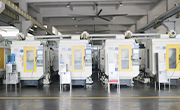Precision molds are an important part of modern industrial production processes, ensuring high quality and efficiency in product production. The mold steel material used for mold processing has high hardness, requiring the mold processing equipment to have thermal stability and high reliability. The refinement of mold processing makes the complexity and efficiency of the processing equipment more attractive. So what are the three factors that affect the precision of mold processing? 1. Processing accuracy and error:
Both machining accuracy and machining error are terms used to evaluate the geometric parameters of the machined surface. The machining accuracy of precision molds is measured by tolerance levels, and the smaller the level value, the higher the accuracy; The machining error is represented by numerical values, and the larger the value, the greater the error. High machining accuracy means small machining errors, and vice versa.
2. Position accuracy
The positional accuracy of precision molds refers to the difference in actual positional accuracy between the relevant surfaces of precision mold processed parts. There are eight items to evaluate positional accuracy: parallelism, verticality, inclination, concentricity, symmetry, position, circular runout, and total runout. The positional accuracy is controlled by positional tolerances, and the positional tolerances of each project are also divided into 12 accuracy levels.
3. Machine quality:
The quality of a machine depends on the processing quality of the parts and the assembly quality of the machine. The machining quality of precision molds includes the machining accuracy and surface quality of the parts. Machining accuracy refers to the degree to which the actual geometric parameters (size, shape, and position) of a part after machining match the ideal geometric parameters. The difference between them is called machining error, and the size of precision mold machining error reflects the level of machining accuracy. The larger the error, the lower the machining accuracy. The smaller the error, the higher the machining accuracy. The main aspects that affect machining accuracy include dimensional accuracy, precision mold processing, and the degree of alignment between the actual dimensions of the machined parts and the center of the tolerance zone of the part dimensions.
So if you want a more refined product, you need to know these influencing factors. The above are the three major factors that affect the precision of mold processing. Today, we will introduce them to you.











